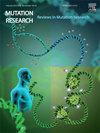缺氧诱导的HIF-1α通过靶向GAB2促进非小细胞肺癌的肿瘤发生
IF 1.9
4区 医学
Q4 BIOTECHNOLOGY & APPLIED MICROBIOLOGY
Mutation Research-Fundamental and Molecular Mechanisms of Mutagenesis
Pub Date : 2025-07-01
DOI:10.1016/j.mrfmmm.2025.111917
引用次数: 0
摘要
非小细胞肺癌(NSCLC)是一种发病率和死亡率都很高的致命疾病。HIF-1α被证实参与NSCLC。然而,其作用的具体机制尚不清楚。我们利用NCI-H226和SK-MES-1细胞系,探讨缺氧在体外影响NSCLC进展的机制。transwell检测细胞功能。采用实时定量反转录PCR (qRT-PCR)和Western Blot检测关键生物标志物的表达。RNA测序分析用于探索HIF-1α的下游靶点。荧光素酶和染色质免疫沉淀(ChIP)实验证实了HIF-1α和GAB2之间的相互作用。此外,采用异种移植物模型研究GAB2在体内的作用。缺氧可促进NCI-H226和SK-MES-1细胞的迁移和侵袭能力。RNA测序分析显示,在缺氧环境下,GAB2的表达发生了显著变化。生物信息学分析提示MEK/ERK信号通路中差异表达基因(DEGs)富集,GAB2显著表达与HIF-1α相关。在功能上,GAB2调节体外迁移和侵袭能力,促进体内NSCLC的肿瘤生长和肺转移。荧光素酶和ChIP实验进一步证实HIF-1α可以与GAB2结合。缺氧诱导的HIF-1α通过靶向GAB2促进非小细胞肺癌的肿瘤生长和肺转移,这可能为GAB2作为非小细胞肺癌的潜在治疗靶点提供新的见解。本文章由计算机程序翻译,如有差异,请以英文原文为准。
Hypoxia-induced HIF-1α enhanced the tumorigenesis in non-small cell lung cancer by targeting GAB2
Non-small cell lung cancer (NSCLC) is a lethal disease with high morbidity and mortality rates. HIF-1α is confirmed to be involved in NSCLC. However, the detailed mechanism of its role remains unclear. NCI-H226 and SK-MES-1 cell lines were used to explore the mechanisms by which hypoxia affects the progression of NSCLC in vitro. The cellular functions were detected by transwell. The expressions of key biomarkers were examined by Real-time quantitative reverse transcription PCR (qRT-PCR) and Western Blot assays. The RNA sequencing analysis was used to explore the downstream targets of HIF-1α. Luciferase and Chromatin immunoprecipitation (ChIP) assays confirmed the interaction between HIF-1α and GAB2. What’s more, the xenograft model was used to investigate the effect of GAB2 in vivo. Hypoxia promoted the migration and invasion capabilities of NCI-H226 and SK-MES-1 cells. RNA sequencing analysis revealed that the expression of GAB2 is dramatically altered under a hypoxic environment. The bioinformatics analysis implied that the differentially expressed genes (DEGs) were enriched in the MEK/ERK signaling pathway and the significantly expressed GAB2 was associated with HIF-1α. Functionally, GAB2 regulated migration and invasion capabilities in vitro and facilitated tumor growth and lung metastasis of NSCLC in vivo. What’s more, luciferase and ChIP assays further demonstrated that HIF-1α could bind to GAB2. Hypoxia-induced HIF-1α enhanced tumor growth and lung metastasis in NSCLC by targeting GAB2, which might provide novel insights into GAB2 as a potential therapeutic target for NSCLC.
求助全文
通过发布文献求助,成功后即可免费获取论文全文。
去求助
来源期刊
CiteScore
4.90
自引率
0.00%
发文量
24
审稿时长
51 days
期刊介绍:
Mutation Research (MR) provides a platform for publishing all aspects of DNA mutations and epimutations, from basic evolutionary aspects to translational applications in genetic and epigenetic diagnostics and therapy. Mutations are defined as all possible alterations in DNA sequence and sequence organization, from point mutations to genome structural variation, chromosomal aberrations and aneuploidy. Epimutations are defined as alterations in the epigenome, i.e., changes in DNA methylation, histone modification and small regulatory RNAs.
MR publishes articles in the following areas:
Of special interest are basic mechanisms through which DNA damage and mutations impact development and differentiation, stem cell biology and cell fate in general, including various forms of cell death and cellular senescence.
The study of genome instability in human molecular epidemiology and in relation to complex phenotypes, such as human disease, is considered a growing area of importance.
Mechanisms of (epi)mutation induction, for example, during DNA repair, replication or recombination; novel methods of (epi)mutation detection, with a focus on ultra-high-throughput sequencing.
Landscape of somatic mutations and epimutations in cancer and aging.
Role of de novo mutations in human disease and aging; mutations in population genomics.
Interactions between mutations and epimutations.
The role of epimutations in chromatin structure and function.
Mitochondrial DNA mutations and their consequences in terms of human disease and aging.
Novel ways to generate mutations and epimutations in cell lines and animal models.

 求助内容:
求助内容: 应助结果提醒方式:
应助结果提醒方式:


